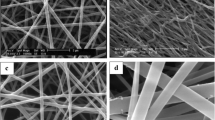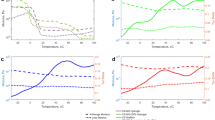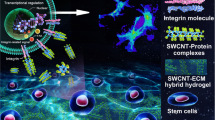Abstract
Cardiac tissue engineering is of great importance for therapeutic and pharmaceutical applications. The scaffolds that can provide electrical conductivity and structural organization will be highly beneficial for cardiac tissue engineering. Here, we developed conductive scaffolds with electrical conductivity and porous structure composed of chitosan (CS) blending with graphene oxide (GO) for cardiac tissue engineering. Our results showed that the swelling, porosity, and conductive properties of GO/CS scaffolds could be modulated via adjusting the ratio of GO to CS. More importantly, GO/CS scaffolds had a swelling ratio ranging from 23.20 to 27.38 (1000%) and their conductivity (0.134 S/m) fell in the range of reported conductivities for native cardiac tissue. Furthermore, we assessed their biological activity by seeding heart H9C2 cells in GO/CS scaffolds. Our data showed that these GO/CS scaffolds exhibited good cell viability, promotion of cell attachment and intercellular network formation, and upregulation of the cardiac-specific gene and protein expression involved in muscle conduction of electrical signals (Connexin-43). Overall, it is concluded that the GO/CS scaffolds promote the properties of cardiac tissue constructs. Our findings provide a new strategy and insight in developing new scaffolds for cardiac tissue engineering.





Similar content being viewed by others
References
Kikuchi, K., & Poss, K. D. (2012). Cardiac regenerative capacity and mechanisms [J]. Annual Review of Cell and Developmental Biology, 28(1), 719–741.
Dvir, T., Timko, B. P., Brigham, M. D., Naik, S. R., Karajanagi, S. S., Levy, O., Jin, H., Parker, K. K., Langer, R., & Kohane, D. S. (2011). Nanowired three-dimensional cardiac patches [J]. Nature Nanotechnology, 6(11), 720–725.
Wang, F., & Guan, J. (2010). Cellular cardiomyoplasty and cardiac tissue engineering for myocardial therapy [J]. Advanced Drug Delivery Reviews, 62(7–8), 784–797.
Dai, X., Zhou, W., Gao, T., Liu, J., & Lieber, C. M. (2016). Three-dimensional mapping and regulation of action potential propagation in nanoelectronics-innervated tissues [J]. Nature Nanotechnology, 11(9), 776–782.
Engelmayr, G. C., Jr., Cheng, M., Bettinger, C. J., Borenstein, J. T., Langer, R., & Freed, L. E. (2008). Accordion-like honeycombs for tissue engineering of cardiac anisotropy [J]. Nature Materials, 7(12), 1003–1010.
Shin, S. R., Aghaei-Ghareh-Bolagh, B., Gao, X., Nikkhah, M., Jung, S. M., Dolatshahi-Pirouz, A., Kim, S. B., Kim, S. M., Dokmeci, M. R., Tang, X. S., & Khademhosseini, A. (2014). Layer-by-layer assembly of 3D tissue constructs with functionalized graphene [J]. Advanced Functional Materials, 24(39), 6136–6144.
Baei, P., Jalili-Firoozinezhad, S., Rajabi-Zeleti, S., Tafazzoli-Shadpour, M., Baharvand, H., & Aghdami, N. (2016). Electrically conductive gold nanoparticle-chitosan thermosensitive hydrogels for cardiac tissue engineering [J]. Materials Science & Engineering, C: Materials for Biological Applications, 63, 131–141.
Martins, A. M., Eng, G., Caridade, S. G., Mano, J. F., Reis, R. L., & Vunjak-Novakovic, G. (2014). Electrically conductive chitosan/carbon scaffolds for cardiac tissue engineering [J]. Biomacromolecules, 15(2), 635–643.
Jithendra, P., Rajam, A. M., Kalaivani, T., Mandal, A. B., & Rose, C. (2013). Preparation and characterization of aloe vera blended collagen-chitosan composite scaffold for tissue engineering applications [J]. ACS Applied Materials & Interfaces, 5(15), 7291–7298.
Choi, B., Kim, S., Lin, B., Wu, B. M., & Lee, M. (2014). Cartilaginous extracellular matrix-modified chitosan hydrogels for cartilage tissue engineering [J]. ACS Applied Materials & Interfaces, 6(22), 20110–20121.
Philibert, T., Lee, B. H., & Fabien, N. (2017). Current status and new perspectives on chitin and chitosan as functional biopolymers [J]. Applied Biochemistry and Biotechnology, 181(4), 1314–1337.
Zhang, T., Jin, L., Fang, Y., Lin, F., Sun, W., & Xiong, Z. (2014). Fabrication of biomimetic scaffolds with oriented porous morphology for cardiac tissue engineering [J]. Journal of Biomaterials and Tissue Engineering, 4(12), 1030–1039.
Rabbani, S., Soleimani, M., Imani, M., Sahebjam, M., Ghiaseddin, A., Nassiri, S. M., Majd Ardakani, J., Tajik Rostami, M., Jalali, A., Mousanassab, B., Kheradmandi, M., & Ahmadi Tafti, S. H. (2017). Regenerating heart using a novel compound and human Wharton jelly mesenchymal stem cells [J]. Archives of Medical Research, 48(3), 228–237.
Zhu, Y. X., Song, K. D., Jiang, S. Y., Chen, J. L., Tang, L. Z., Li, S. Y., Fan, J., Wang, Y., Zhao, J., & Liu, T. (2017). Numerical simulation of mass transfer and three-dimensional fabrication of tissue-engineered cartilages based on chitosan/gelatin hybrid hydrogel scaffold in a rotating bioreactor [J]. Applied Biochemistry and Biotechnology, 181(1), 250–266.
Mihic, A., Cui, Z., Wu, J., Vlacic, G., Miyagi, Y., Li, S. H., Lu, S., Sung, H. W., Weisel, R. D., & Li, R. K. (2015). A conductive polymer hydrogel supports cell electrical signaling and improves cardiac function after implantation into myocardial infarct [J]. Circulation, 132(8), 772–784.
Seokwon, P., Flavia, V., Eichmann, S. L., Benavides, O. M., Matteo, P., & Jacot, J. G. (2014). Biocompatible carbon nanotube-chitosan scaffold matching the electrical conductivity of the heart [J]. ACS Nano, 28(8), 10.
Liu, X., Miller, A. L., 2nd, Park, S., Waletzki, B. E., Zhou, Z., Terzic, A., et al. (2017). Functionalized carbon nanotube and graphene oxide embedded electrically conductive hydrogel synergistically stimulates nerve cell differentiation [J]. ACS Applied Materials & Interfaces, 9(17), 14677–14690.
Jing, X., Mi, H.-Y., Napiwocki, B. N., Peng, X.-F., & Turng, L.-S. (2017). Mussel-inspired electroactive chitosan/graphene oxide composite hydrogel with rapid self-healing and recovery behavior for tissue engineering [J]. Carbon, 125, 557–570.
Jooyeon, P., Bokyoung, K., Jin, H., Jaewon, O., Subeom, P., Seungmi, R., et al. (2015). Graphene oxide flakes as a cellular adhesive: prevention of reactive oxygen species mediated death of implanted cells for cardiac repair [J]. ACS Nano, 26(9), 5.
Waiwijit, U., Maturos, T., Pakapongpan, S., Phokharatkul, D., Wisitsoraat, A., & Tuantranont, A. (2016). Highly cytocompatible and flexible three-dimensional graphene/polydimethylsiloxane composite for culture and electrochemical detection of L929 fibroblast cells [J]. Journal of Biomaterials Applications, 31(2), 230–240.
Han, Y., Zeng, Q., Li, H., & Chang, J. (2013). The calcium silicate/alginate composite: preparation and evaluation of its behavior as bioactive injectable hydrogels [J]. Acta Biomaterialia, 9(11), 9107–9117.
Shamekhi, M. A., Rabiee, A., Mirzadeh, H., Mahdavi, H., Mohebbi-Kalhori, D., & Baghaban, E. M. (2017). Fabrication and characterization of hydrothermal cross-linked chitosan porous scaffolds for cartilage tissue engineering applications [J]. Materials Science & Engineering, C: Materials for Biological Applications, 80, 532–542.
Wan, S., Peng, J., Li, Y., Hu, H., Jiang, L., & Cheng, Q. (2015). Use of synergistic interactions to fabricate strong, tough, and conductive artificial nacre based on graphene oxide and chitosan [J]. ACS Nano, 9(10), 9830–9836.
Thein-Han, W. W., & Misra, R. D. (2009). Biomimetic chitosan-nanohydroxyapatite composite scaffolds for bone tissue engineering [J]. Acta Biomaterialia, 5(4), 1182–1197.
Stout, D. A., Yoo, J., Santiago-Miranda, A. N., & Webster, T. J. (2012). Mechanisms of greater cardiomyocyte functions on conductive nanoengineered composites for cardiovascular application [J]. International Journal of Nanomedicine, 7, 5653–5669.
Roell, W., Lewalter, T., Sasse, P., Tallini, Y. N., Choi, B. R., Breitbach, M., Doran, R., Becher, U. M., Hwang, S. M., Bostani, T., von Maltzahn, J., Hofmann, A., Reining, S., Eiberger, B., Gabris, B., Pfeifer, A., Welz, A., Willecke, K., Salama, G., Schrickel, J. W., Kotlikoff, M. I., & Fleischmann, B. K. (2007). Engraftment of connexin 43-expressing cells prevents post-infarct arrhythmia [J]. Nature, 450(7171), 819–824.
Kim, Y. H., Choi, S. H., D'Avanzo, C., Hebisch, M., Sliwinski, C., Bylykbashi, E., Washicosky, K. J., Klee, J. B., Brüstle, O., Tanzi, R. E., & Kim, D. Y. (2015). A 3D human neural cell culture system for modeling Alzheimer's disease [J]. Nature Protocols, 10(7), 985–1006.
Radisic, M., Park, H., Shing, H., Consi, T., Schoen, F. J., Langer, R., Freed, L. E., & Vunjak-Novakovic, G. (2004). Functional assembly of engineered myocardium by electrical stimulation of cardiac myocytes cultured on scaffolds [J]. Proceedings of the National Academy of Sciences of the United States of America, 101(52), 18129–18134.
Pok, S., Vitale, F., Eichmann, S. L., Benavides, O. M., Pasquali, M., & Jacot, J. G. (2015). Biocompatible carbon nanotube-chitosan scaffold matching the electrical conductivity of the heart [J]. ACS Nano, 8(10), 9822–9832.
Wu, Y., Wang, L., Guo, B., & Ma, P. X. (2017). Interwoven aligned conductive nanofiber yarn/hydrogel composite scaffolds for engineered 3D cardiac anisotropy [J]. ACS Nano, 11(6), 5646–5659.
Hollister, S. (2005). Porous scaffold design for tissue engineering [J]. Nature Materials, 4(7), 518–524.
Jang, J., Park, H. J., Kim, S. W., Kim, H., Park, J. Y., Na, S. J., Kim, H. J., Park, M. N., Choi, S. H., Park, S. H., Kim, S. W., Kwon, S. M., Kim, P. J., & Cho, D. W. (2017). 3D printed complex tissue construct using stem cell-laden decellularized extracellular matrix bioinks for cardiac repair [J]. Biomaterials, 112, 264–274.
You, J. O., Rafat, M., Ye, G. J., & Auguste, D. T. (2011). Nanoengineering the heart: conductive scaffolds enhance connexin 43 expression [J]. Nano Letters, 11(9), 3643–3648.
Shin, S. R., Jung, S. M., Zalabany, M., Kim, K., Zorlutuna, P., Kim, S. B., et al. (2013). Carbon-nanotube-embedded hydrogel sheets for engineering cardiac constructs and bioactuators [J]. ACS Nano, 7(3), 2369–2380.
Gao, Y., Connell, J. P., Wadhwa, L., Ruano, R., & Jacot, J. G. (2014). Amniotic fluid-derived stem cells demonstrated cardiogenic potential in indirect co-culture with human cardiac cells [J]. Annals of Biomedical Engineering, 42(12), 2490–2500.
Hao, T., Zhou, J., Lu, S., Yang, B., Wang, Y., Fang, W., et al. (2016). Fullerene mediates proliferation and cardiomyogenic differentiation of adipose-derived stem cells via modulation of MAPK pathway and cardiac protein expression [J]. International Journal of Nanomedicine, 11, 269–283.
Wong Cheng, L., Lim, C. H. Y. X., Hui, S., Tang, L. A. L., Yu, W., Chwee Teck, L., et al. (2011). Origin of enhanced stem cell growth and differentiation on graphene and graphene oxide [J]. ACS Nano, 27(5), 9.
Funding
This study was supported by the National Key Research and Development Program of China (2017YFC1702006), the National Natural Science Foundation of China [31400307], the Fundamental Research Funds for the Central Universities [DUT14RC(3)016, DUT16RC(4)73]; the Liaoning Natural Science Foundation of China [201601033]; and the General Projects of Liaoning Education Department Science and Research Foundation [L2015111].
Author information
Authors and Affiliations
Corresponding author
Ethics declarations
Conflict of Interest
The authors declare that they have no competing interests.
Additional information
Publisher’s Note
Springer Nature remains neutral with regard to jurisdictional claims in published maps and institutional affiliations.
Electronic Supplementary Material
ESM 1
(DOCX 162 kb)
Rights and permissions
About this article
Cite this article
Jiang, L., Chen, D., Wang, Z. et al. Preparation of an Electrically Conductive Graphene Oxide/Chitosan Scaffold for Cardiac Tissue Engineering. Appl Biochem Biotechnol 188, 952–964 (2019). https://doi.org/10.1007/s12010-019-02967-6
Received:
Accepted:
Published:
Issue Date:
DOI: https://doi.org/10.1007/s12010-019-02967-6




